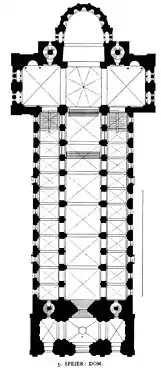%252C_cath%C3%A9drale_Notre-Dame%252C_ch%C5%93ur%252C_2e_et_3e_trav%C3%A9e%252C_grandes_arcades_du_nord.jpg.webp)
Alternation of supports is a trait of Romanesque architecture (and Early Gothic[1]), where the supports in a colonnade or arcade have different types. For example, periodic change between the strong supports (piers) and the weak ones (columns) provides visually obvious alternating supports. More subtle alternation can result, for example, from variations of the column shafts.[2]

The technique became common at the end of the 10th century[3] and appears to be coupled with the use of transverse arches:[4] the arches rested on the tops of the stronger piers. The double-bay system, with its side aisles at a half of the width of the nave, required columns for the aisle vaults placed at half the step for the transverse arches of the nave,[5] the additional columns sometimes carried smaller load and thus can be thinner.

The use of alternating supports was largely abandoned with the introduction of Gothic architecture and its more malleable pointed arches. There were some notable exceptions, however: for example, the lateral aisles of the Notre-Dame de Paris have alternating piers of lower and greater strength that provide a "powerful appeal to the eye and the senses", but had originally fulfilled a structural need, as the heavier piers carried an extra load from the intermediate supports in the buttress system. Also, the alternation can be found in some early Gothic designs of sexpartite vaults, where the support for the middle transverse rib carries less load.[1]
References
- 1 2 Jantzen 1984, p. 13.
- ↑ Vadna, Jane (1997). "alternation of supports". Glossary of Medieval Art and Architecture. University of Pittsburgh. Retrieved 25 December 2023.
- ↑ Frankl 1918, p. 58.
- ↑ Frankl 1918, p. 218.
- ↑ Davies & Jokiniemi 2008, p. 478.
Sources
- Frankl, P. (1918). Die Baukunst des Mittelalters. Handbuch der Kunstwissenschaft (in German). Akademische Verlagsgesellschaft Athenaion. Retrieved 2023-12-25.
- Humann, G. (1925). Stützenwechsel in der Romanischen Baukunst. Studien zur deutschen Kunstgeschichte (in German). J.H. Ed. Heitz. Retrieved 2023-12-25.
- Davies, N.; Jokiniemi, E. (2008). "Roman and Romanesque Vaulting". Dictionary of Architecture and Building Construction. Taylor & Francis. ISBN 978-1-136-41026-0. Retrieved 2023-12-25.
- Jantzen, H. (1984). High Gothic: The Classic Cathedrals of Chartres, Reims, Amiens. Princeton paperbacks. Princeton University Press. ISBN 978-0-691-00372-6. Retrieved 2023-12-26.